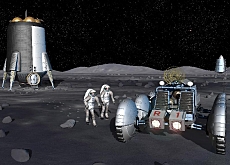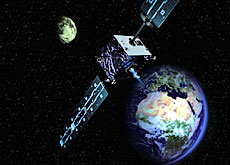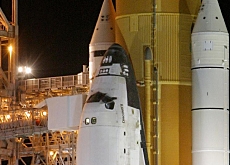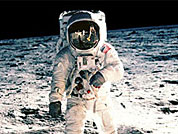Plans to build bases on moon “long overdue”

A Swiss space expert has welcomed Nasa's decision to build a permanently occupied base on the moon.
Bruno Stanek, who covered the 1969 Apollo landing for Swiss television, told swissinfo that for a comparable amount of money the space station programme had led to a “dead end”.
Unveiling the agency’s plan for a return to the moon, Nasa said on Monday it would establish an international base camp on one of the moon’s poles, permanently staffing it by 2024, four years after astronauts land there.
“This was long overdue,” Stanek said. “The International Space Station and the sophisticated – and luxurious! – space shuttle always ate up a lot of the Nasa budget. The new plans for flights to the moon and beyond just want to spend the same limited funds in a more efficient and focused way.”
The plans represent a sweeping departure from the Apollo moon missions of the 1960s and will open a new phase of space exploration after the shuttles are retired in 2010.
Nasa said the first step in establishing the base would be a new generation of lunar spaceships, which would undergo tests from 2009.
Manned flights would begin in 2014 and astronauts would land on the moon – for the first time since the final Apollo mission in 1972 – in 2020.
“Life insurance”
Nasa currently has a budget of about $16 billion (SFr19 billion) a year but it is not expecting a budget increase to pay for the programme. Rather, it will shift funds currently used to support the shuttle into the moon exploration programme as the shuttle fleet is phased out.
The agency said the two key reasons for establishing a base were to prepare for a manned mission for Mars and ultimately the expansion of human civilisation to other planets.
“Mars is the planet with most ‘living space’ next to Earth,” Stanek told swissinfo. “But Mars is good for millions, not for billions like Earth.”
Nevertheless he described a second planet as “the best life insurance” – in terms of the “scientific understanding of Earth in the context of planetary exploration, and giving us the means to prevent being hit by asteroids or one day stabilising our average temperature”.
Scientists fear that an asteroid hitting the Earth would have a similarly catastrophic effect to the one which is thought to have wiped out the dinosaurs 65 million years ago.
In addition, global warming is an issue about which few scientists are optimistic in the long term.
Assistance
But Nasa’s vision for the moon is more than just American astronauts. The US will look for international and commercial partners to share the expense and possibly provide components such as additional power systems, living quarters and resources for surface travel on the moon.
Switzerland has long been an active participant in the space race, being one the founders of the European Space Agency.
“We’ve always had some centres of excellence in Switzerland,” Stanek said.
Swiss industry and research institutes have regularly supplied parts and instruments for the spacecraft and probes that travel across the solar system.
Indeed, Neil Armstrong and Buzz Aldrin were wearing Swiss Omega watches when they landed on the moon on July 20, 1969.
swissinfo, Thomas Stephens
In 2006, Switzerland contributed SFr140 million ($116 million) to the budget of the European Space Agency (ESA), or around 3.4 per cent.
In 2005, the Swiss space industry’s turnover was SFr170 million.
Switzerland was one the founders of the European Space Agency, but it also collaborates with other agencies.
The Swiss space industry includes 28 research institutes and 54 companies. Apart from Contraves, these firms all have fewer than 200 employees.
They specialise mostly in ground equipment, optical apparatuses, telecommunications systems, clocks, robotic machinery, microgravity research, and weather surveillance.
Switzerland is the homeland of Claude Nicollier, astrophysicist, test pilot and astronaut. He was the first foreigner granted mission specialist status by Nasa.
He completed four missions on board the space shuttle, and spent over eight hours on spacewalks.
Bruno Stanek is a leading Swiss expert and writer on space issues.
2009: a first test of one of the lunar spaceships.
2014: the first manned test flight of the Orion crew exploration vehicle, but no moon landing.
2020: the first flight of the four-astronaut crew to the moon.
2024: The international base will be permanently staffed.

In compliance with the JTI standards
More: SWI swissinfo.ch certified by the Journalism Trust Initiative




You can find an overview of ongoing debates with our journalists here . Please join us!
If you want to start a conversation about a topic raised in this article or want to report factual errors, email us at english@swissinfo.ch.